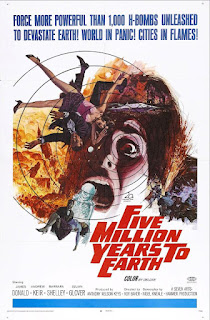Quatermass and the Pit (1967)
Hammer, best known for horror, occasionally dipped its toe into science fiction as well. Since it was a British studio it had great success adapting an already popular BBC television series to the screen. Dr. Quatermass, played by Reginald Tate and, for the third series upon which Quatermass and the Pit is based, by André Morell. The other two movies, The Quatermass Xperiment (released in the U.S. as The Creeping Unknown) and Quatermass 2 (U.S. title Enemy from Space), starred Brian Donlevy as the titular hero.
The reason for the name changes, including this one which was released as Five Million Years to Earth, is that Americans largely had no knowledge of the Quatermass television serials. Unlike the later Doctor Who program the Quatermass series were never broadcast in the United States. While the stories were praised for their mature plots and excellent writing, and happily survived the BBC wiping of old shows, the character remained a uniquely British one. Despite that the movies were still popular in the U.S. even if the audience was unaware that they shared a connection. It also did not help that there was a 10-year gap between Quatermass 2 and Quatermass and the Pit.
When workers digging out an underground extension in the London neighborhood near Hobb's Lane discover remains of human ancestors work comes to a halt. Archaeologist Dr. Roney (James Donald) and his assistant Barbara Judd (Barbara Shelley) begin an excavation, finding additional remains and, eventually, what appears to be an unexploded bomb from World War II. A bomb disposal unit led by Captain Potter (Bryan Marshall) is sent in to deal with it, but its strange characteristics lead to the investigation being turned over to Colonel Breen (Julian Glover), who just happens to have Dr. Bernard Quatermass (Andrew Kier) in tow as the two have been ordered to work together on establishing military bases on the Moon and Mars.
Rather than a German bomb the object turns out to be a spaceship, and it appears that it may have been responsible for strange occurrences associated with the area going back to antiquity. It is determined the remains and the ship date back around five million years, and efforts to open the ship eventually lead to the discovery of insectoid creatures that are theorized to have come from a dying Mars. While its occupants may be dead the ship itself appears to be alive, despite Breen's attempts to pass it off as a German propaganda attempt. As Quatermass and Roney work out the truth it becomes evident that the human race is in grave danger as it learns uncomfortable truths about its origin.
What makes this movie unique is the Nigel Kneale, who was one of the writers on the original story, also wrote the screenplay. Roy Ward Baker, who took over directing from Val Guest, took the story seriously, and due to Elstree Studios not being available the production was able to utilize MGM's UK studios. Thus, what was a modestly budgeted sci-fi film managed to look a lot more expensive.
It also helps that Andrew Kier is a more memorable Quatermass than Brian Donlevy. The first two films are good, but they lack the intricacies of this one. Quatermass and the Pit requires a Quatermass that one could believe would have the scientific gravitas to be taken seriously but also a quirky arrogance that makes him aloof without resorting to slapstick. This also bucks the trend of turning either leads into action heroes, thus making their responses to a crisis situation seem that much more believable. It also allows them to catastrophically fail without it taking away from the movie. The other thing this movie does right is doing away with forced romantic plotting, which is quite refreshing for an older sci-fi film.
I don't mind the dated effects - they're actually pretty good for 1967 and a Hammer budget - but some of the science has changed over the years, and other things, like Roney's machine that can record memories, are still pretty much fiction. I know Kneale did his best with what was known at the time, or at least to make the plot seem scientifically plausible. At least the reason for there being a missing link found in England is pretty much explained, since it is hinted that the human-like creatures are not really supposed to have been there, which would also explain why Roney would get so excited about his find.
It is still a well-written, and different, science fiction film. Just don't expect the typical introspective happy ending that most American films from the 1950s had, nor for the military to save the day. Quatermass and the Pit as a decidedly anti-military bent to it as well as jabs against British bureaucracy. It is a complex film, and despite all that it manages to hold one's interest as the story unfolds.
Quatermass and the Pit (1967)
Time: 97 minutes
Starring: Andrew Kier, James Donald, Barbara Shelley, Julian Glover
Director: Roy Ward Baker




Julian Glover was all of 32 when this was made, which is rather young for a Colonel, especially in peacetime. He was much more convincing as General Veers -- the one competent officer in the Imperial armed forces -- in The Empire Strikes Back.
ReplyDelete